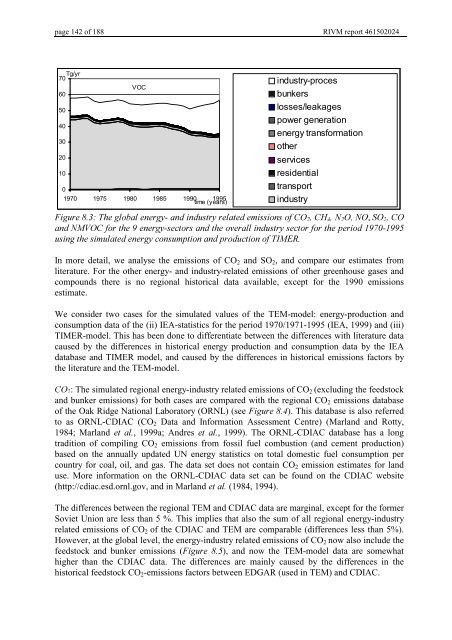Targets IMage Energy Regional (TIMER) Model, Technical ...
Targets IMage Energy Regional (TIMER) Model, Technical ...
Targets IMage Energy Regional (TIMER) Model, Technical ...
Create successful ePaper yourself
Turn your PDF publications into a flip-book with our unique Google optimized e-Paper software.
page 142 of 188 RIVM report 461502024<br />
Tg/yr<br />
70<br />
60<br />
50<br />
40<br />
30<br />
20<br />
10<br />
VOC<br />
0<br />
1970 1975 1980 1985 1990 1995<br />
time (years)<br />
industry-proces<br />
bunkers<br />
losses/leakages<br />
power generation<br />
energy transformation<br />
other<br />
services<br />
residential<br />
transport<br />
industry<br />
)LJXUH7KHJOREDOHQHUJ\DQGLQGXVWU\UHODWHGHPLVVLRQVRI&2 &+ 1 212 [Ã 62 &2<br />
DQG1092&IRUWKHHQHUJ\VHFWRUVDQGWKHRYHUDOOLQGXVWU\VHFWRUIRUWKHSHULRG<br />
XVLQJWKHVLPXODWHGHQHUJ\FRQVXPSWLRQDQGSURGXFWLRQRI7,0(5<br />
In more detail, we analyse the emissions of CO 2 and SO 2 , and compare our estimates from<br />
literature. For the other energy- and industry-related emissions of other greenhouse gases and<br />
compounds there is no regional historical data available, except for the 1990 emissions<br />
estimate.<br />
We consider two cases for the simulated values of the TEM-model: energy-production and<br />
consumption data of the (ii) IEA-statistics for the period 1970/1971-1995 (IEA, 1999) and (iii)<br />
<strong>TIMER</strong>-model. This has been done to differentiate between the differences with literature data<br />
caused by the differences in historical energy production and consumption data by the IEA<br />
database and <strong>TIMER</strong> model, and caused by the differences in historical emissions factors by<br />
the literature and the TEM-model.<br />
&2 : The simulated regional energy-industry related emissions of CO 2 (excluding the feedstock<br />
and bunker emissions) for both cases are compared with the regional CO 2 emissions database<br />
of the Oak Ridge National Laboratory (ORNL) (see )LJXUH). This database is also referred<br />
to as ORNL-CDIAC (CO 2 Data and Information Assessment Centre) (Marland and Rotty,<br />
1984; Marland HW DO, 1999a; Andres HW DO, 1999). The ORNL-CDIAC database has a long<br />
tradition of compiling CO 2 emissions from fossil fuel combustion (and cement production)<br />
based on the annually updated UN energy statistics on total domestic fuel consumption per<br />
country for coal, oil, and gas. The data set does not contain CO 2 emission estimates for land<br />
use. More information on the ORNL-CDIAC data set can be found on the CDIAC website<br />
(http://cdiac.esd.ornl.gov, and in Marland HWDO (1984, 1994).<br />
The differences between the regional TEM and CDIAC data are marginal, except for the former<br />
Soviet Union are less than 5 %. This implies that also the sum of all regional energy-industry<br />
related emissions of CO 2 of the CDIAC and TEM are comparable (differences less than 5%).<br />
However, at the global level, the energy-industry related emissions of CO 2 now also include the<br />
feedstock and bunker emissions ()LJXUH ), and now the TEM-model data are somewhat<br />
higher than the CDIAC data. The differences are mainly caused by the differences in the<br />
historical feedstock CO 2 -emissions factors between EDGAR (used in TEM) and CDIAC.
















